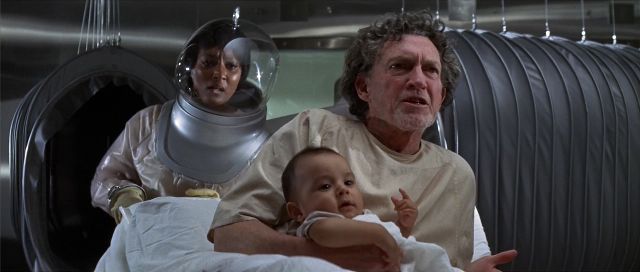The Andromeda Strain (1971) 
“The picture runs 130 minutes!… The story covers 96 of the most critical hours in man’s history!… The suspense will last through your lifetime!”

Director: Robert Wise
Cast: James Olson, Arthur Hill, David Wayne
Synopsis: A group of scientists investigates a deadly new alien virus before it can spread.
The Andromeda Strain, Robert Wise’s adaptation of an early Michael Crichton SF novel, must be unique in the way that it tells the story of a biological threat to the human race from outer space largely by having a bunch of boffins staring at screens in grey rooms and spouting technobabble. It’s to Wise’s credit, then, that he at least manages to prevent the movie from being a bore-fest, even though he struggles to involve us in the events unfolding onscreen. Having said that, any SF movie that attempts to deal with a subject like this in such an intelligent and realistic manner has to be applauded. Because, let’s face it, in reality the behind-the-scenes work involved in saving the world is probably just as dull as most other jobs…
The movie’s budgetary constraints are evident from the outset when, instead of seeing a couple of soldiers meet their deaths while visiting the tiny town of Piedmont (pop. 68, and falling quickly) in New Mexico, we see a group of guys sitting in an office reacting to what they’re hearing over speakers. The soldiers, it seems, are something to do with Project Scoop, and are searching for the landing site of a military space capsule. It seems, however, that the capsule has brought something nasty back from its journey into space and, as soon as the soldiers’ deaths are confirmed, military types are sent out to round up a select bunch of scientists to deal with the situation.
These scientists are, as you’d expect, something of a mixed bunch. Chief amongst them is Jeremy Stone (Arthur Hill), who seems the most clued in on what’s going on, and who provides the testimony to a Senate hearing that provides the framing device for the story. Then there’s Charles Dutton (David Wayne), an older gentleman, and Dr Ruth Leavitt (Kate Reid), a wry, cynical middle-aged woman who, it turns out, is hiding a secret that almost scuppers the entire operation. Finally, we have Mark Hall (James Olson), who more closely resembles the accepted hero template for this kind of thing. Hall is young and athletic, and displays something of a devil-may-care attitude when he confesses he failed to read any of the official prep manuals posted to him months before.
These four scientists all make their way to a desert-based government Agricultural Research Centre which is, of course, actually a front for the ‘Wildfire’ facility, a secret space research centre housed in a cylindrical underground structure with five circular levels branching off from it. It’s at this point that the film almost grinds to a halt as we’re treated to a potted history of the facility and its purpose, and then travel down its levels with the four scientists. Each level is more sterile than the previous, meaning they must go through progressively more strenuous decontamination procedures before they can gain access to the next level.
It turns out that Hall was selected largely because he’s a single man which apparently means that statistically he’s more likely to be unburdened by emotional baggage which might compel others in his position to disarm the nuclear detonator which is primed to automatically explode if the facility becomes contaminated by whatever has apparently killed the residents of Piedmont. For this reason, it’s Hall who is presented with the key for disarming the detonator. Do you think this will play an important part later in the film? You betcha. Personally, this single man theory seems awfully shaky to me. After all, not all single men are alike, and self-preservation is man’s most powerful instinct. Still, what do I know? Anyway, with this plot point out of the way, our four unlikely saviours set about trying to identify the bug that killed all those unlikely residents.
Fortunately for them and the world, though, the bug didn’t kill everyone. While a creepy tour of the town reveals that most of its residents died immediately as their blood literally turned to powder in their veins, a couple of residents had time to commit suicide (one of them in, quite frankly, the most ludicrous method imaginable) and two are still alive. One of them’s an old man who proves a little troublesome, while the other’s a tiny baby who cries incessantly. By identifying what common denominator these two share, the scientists hope to be able to identify the bug and defeat it.
I’ve got to admit, I struggled with this one. The story is intelligently written and does manage to build a level of tension despite largely taking place within the bland walls of the sterile Wildfire facility, but there are a couple of plot twists that seem ridiculously contrived. The first is that secret of Dr Leavitt’s I mentioned earlier which almost spells disaster for the operation, the other is a convenient mutation of the bug that serves no other purpose than to provide an excuse for a frantic concluding race against time to shut down one of those automated computers which likes to inform its doomed owners just how many seconds remain until they are to be turned into radioactive dust by the nuclear bomb it intends to explode. And while outdated technology is no reason to dislike a movie, those computers all look impossibly quaint today to the point that it’s difficult to believe they could handle a game of Pong, let alone the complex operations that they’re called upon to perform here.
(24th September 2013)
httpv://www.youtube.com/watch?v=8qEsqjJAY-k
